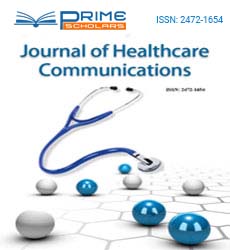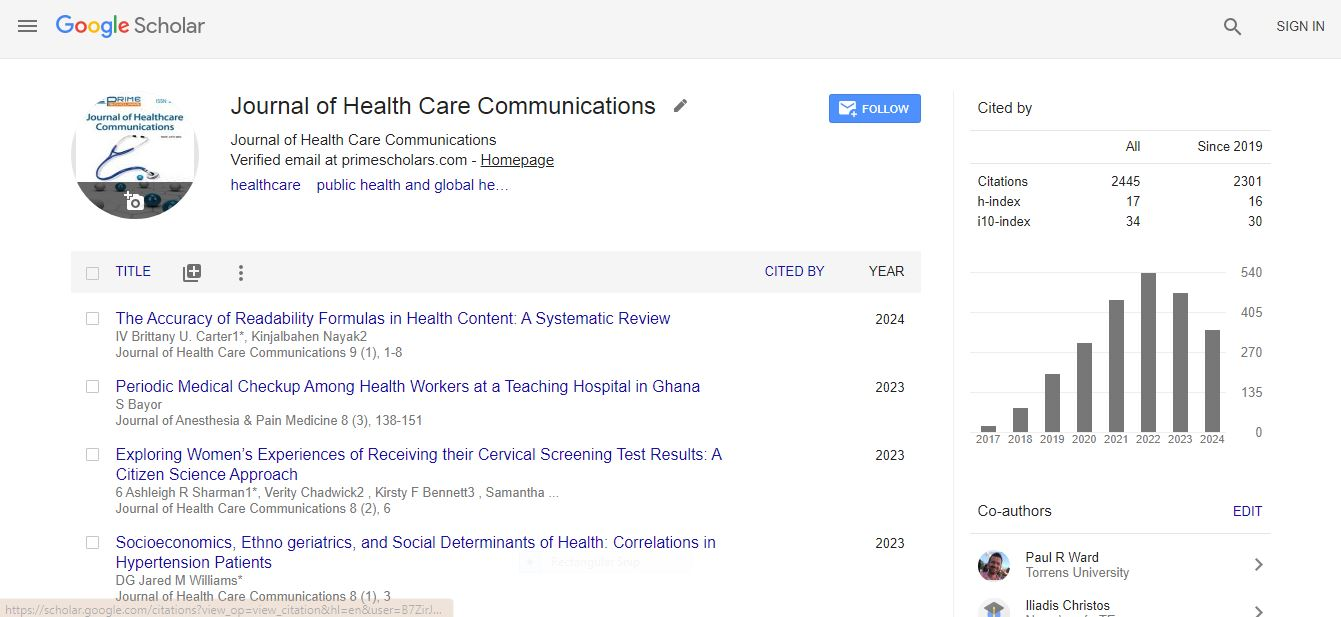Perspective - (2025) Volume 10, Issue 2
Healthcare Materials: Communication in Design, Safety and Use
Louis Chen*
Department of Emergency Medicine, University of Washington, Seattle, USA
*Correspondence:
Louis Chen, Department of Emergency Medicine, University of Washington, Seattle,
USA,
Email:
Received: 03-Jun-2025, Manuscript No. IPJHCC-25-22774;
Editor assigned: 05-Jun-2025, Pre QC No. IPJHCC-25-22774 (PQ);
Reviewed: 19-Jun-2025, QC No. IPJHCC-25-22774;
Revised: 26-Jun-2025, Manuscript No. IPJHCC-25-22774 (R);
Published:
03-Jul-2025, DOI: 10.36846/2472-1654.25.10.67
Description
Healthcare materials form the physical foundation of medical practice, encompassing everything from surgical instruments and diagnostic tools to implants, prosthetics and protective equipment. These materials must meet high standards of safety, durability and functionality to ensure that patients receive effective treatment. However, their development, selection and application are deeply influenced by communication among manufacturers, healthcare professionals, regulators and patients. Clear communication ensures that materials are understood, trusted and used appropriately, ultimately contributing to patient safety and quality of care.
The communication process around healthcare materials begins with research and development. Scientists and engineers design new biomaterials, medical devices and pharmaceutical packaging based on clinical needs. Collaboration with physicians and nurses is crucial during this stage, as their input helps refine material properties to suit real-world applications. For example, orthopedic surgeons may advise on the durability and flexibility required in joint implants, while infection-control specialists may suggest antimicrobial properties for hospital textiles. Without structured communication between developers and end users, materials may fail to meet clinical expectations.
Regulatory communication plays an equally important role. Healthcare materials must be evaluated for safety and compliance before they can enter the market. Agencies such as the U.S. Food and Drug Administration (FDA) or the European Medicines Agency (EMA) require detailed documentation on material composition, testing protocols and risk assessments. Clear communication between manufacturers and regulators ensures that requirements are met and that potential hazards are addressed before products are approved. Miscommunication in this process can lead to costly delays, recalls, or, in severe cases, harm to patients.
Once materials are in use, healthcare professionals rely on accurate communication from suppliers and manufacturers. Instructions for use, sterilization procedures and shelf-life information must be clearly communicated to prevent errors. For instance, improper sterilization of surgical instruments or incorrect storage of temperature-sensitive vaccines can compromise patient safety. Detailed labeling, user manuals and training sessions enhance understanding and ensure correct usage of materials in clinical settings.
Healthcare materials also have a direct communication component with patients. Individuals receiving implants, prosthetics, or medical devices must understand their purpose, maintenance requirements and potential risks. For example, a patient fitted with a pacemaker needs clear instructions on lifestyle adjustments, device monitoring and possible interactions with electronic devices. Simplified brochures, visual demonstrations and digital apps help patients manage their devices effectively, improving outcomes and reducing complications.
The COVID-19 pandemic highlighted the importance of communication in healthcare materials, particularly in the distribution and use of Personal Protective Equipment (PPE). Shortages, counterfeit products and inconsistent guidance created widespread confusion. Healthcare workers needed clear communication about which materials offered effective protection, how to use them properly and how to manage reuse when shortages occurred. This experience demonstrated how essential it is for governments, manufacturers and healthcare organizations to coordinate messaging around material availability and standards during crises.
Sustainability has become an emerging focus in healthcare materials and communication is key to advancing eco-friendly practices. Hospitals generate significant amounts of medical waste, much of it from single-use plastics and disposable items. Manufacturers developing biodegradable materials or reusable devices must communicate their benefits and safety effectively to healthcare organizations. At the same time, providers must educate patients on sustainable practices, such as proper disposal of home-use medical supplies like syringes or test kits. Transparent communication ensures that sustainability goals do not compromise patient safety.
Another dimension is the role of healthcare materials in innovation, such as nanomaterials, 3D-printed implants and smart textiles. These technologies hold great potential, but their adoption depends on how well their functions and risks are communicated to professionals and patients. For example, a 3D-printed bone implant may offer custom fit and rapid production, but surgeons and patients must understand the testing process, durability and regulatory oversight involved. Without clear communication, skepticism and hesitancy may slow adoption of beneficial innovations.
Globalization has also influenced the communication landscape of healthcare materials. Many products are manufactured in one country, regulated in another and used globally. International communication about standards, quality certifications and logistics is essential to ensure consistency and safety across borders. Organizations such as the International Organization for Standardization (ISO) play a role in harmonizing requirements and reducing confusion among stakeholders.
Training and education are critical for the effective use of healthcare materials. Medical and nursing schools increasingly incorporate modules on material safety and device management into their curricula. Continuing education workshops, webinars and simulation training help professionals stay updated on new technologies. Communication in these educational programs ensures that healthcare workers not only understand how to use materials but also how to communicate their benefits and limitations to patients.
Finally, feedback mechanisms are essential for improving healthcare materials. Adverse event reporting systems and post-market surveillance allow clinicians to communicate concerns about material failures or complications. This feedback informs manufacturers and regulators, leading to product improvements and safer outcomes. For example, reports of hip implant failures in the past led to stricter testing and better design of orthopedic materials. Transparent communication in these systems builds accountability and trust.
Conclusion
Healthcare materials underpin the delivery of safe and effective medical care, but their success depends as much on communication as on technical innovation. From development and regulation to patient education and sustainability, clear communication ensures that materials are trusted, understood and used correctly. As new technologies such as nanomaterials, 3D printing and smart devices continue to evolve, effective communication among manufacturers, healthcare professionals, regulators and patients will remain central. By promoting transparency, collaboration and education, healthcare systems can maximize the benefits of materials while safeguarding safety, sustainability and trust.
Citation: Chen L (2025) Healthcare Materials: Communication in Design, Safety and Use. J Health Commun. 10:67.
Copyright: © 2025 Chen L. This is an open-access article distributed under the terms of the Creative Commons Attribution License, which permits unrestricted use, distribution, and reproduction in any medium, provided the original author and source are credited.

